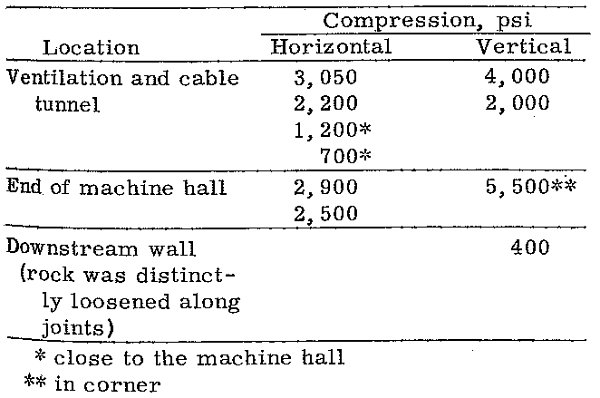Rock mechanics in the investigation and construction of Tumut 1 Underground Power Station, Snowy Mountains, Australia
Since there are no major topographic irregularities it appears that the cause of these high horizontal stresses must be sought in the tectonic history of the region. There are many steeply dipping narrow, basic dikes of uncertain age intrusive into the granite; while still fluid, these intrusions could have exerted strong horizontal pressure on the granite. Other possibilities are that the high horizontal pressure is residual from compression by tectonic forces in the past or is due to tectonic forces now active. Sensitive seismographs recently installed in the Snowy Mountains have recorded occasional small local shocks, but it is too early to assess their significance.
At T. 1 power station the measurements were made after the main excavations were well advanced, and the difficulty of properly determining the effects of these excavations affects the reliability of the computations of the natural stresses. Natural stresses were obtained in the vertical direction and for one horizontal direction at right angles to the longitudinal axis of the machine hall. The actual measured stresses were as follows:

The measurements at T. 2 power-station site were made in the walls and roof of an exploratory tunnel 6 feet wide and 7 feet high driven into the site prior to the commencement of construction, and thus the effects of large complicated excavations were avoided.
The natural stresses at T. 1 and T. 2 show similar features. The compression in the vertical direction is greater than that caused by the weight of rock vertically above the sites. lt is considered that these abnormally high values are probably due to the V-notch effect of the Tumut valley cut into the plateau, modified by the varying properties of the different rock types and geological structures. These effects result in the transfer of part of the stresses due to the weight of the steeply rising ground to the rock below adjacent lower ground. Photoelastic tests on a V-notch of the shape of the Tumut valley cut in a gelatine model demonstrated qualitatively that such stress concentrations were possible (P1. 5b). In this model the principal stresses tended tome normal and parallel respectively to the slope of the sides of the valley.
The topography is more complicated at T. 2 than at T. 1 because of the presence of Eight Mile Creek, which has cut a deep V-shaped valley into the wall of the Tumut valley adjacent to the site. Thus, T. 2 is under a spur between the river and the creek. Topography seems to be the only factor that could account for very high vertical compression more than twice that due to the weight of the rock vertically above the site.
At T. 1 the compression in one horizontal direction is somewhat smaller than the compression in the vertical direction. At T. 2 the compression in two horizontal directions at right angles is nearly equal, and both are somewhat larger than the compression in the vertical direction. The direction of the principal stresses is not known.
